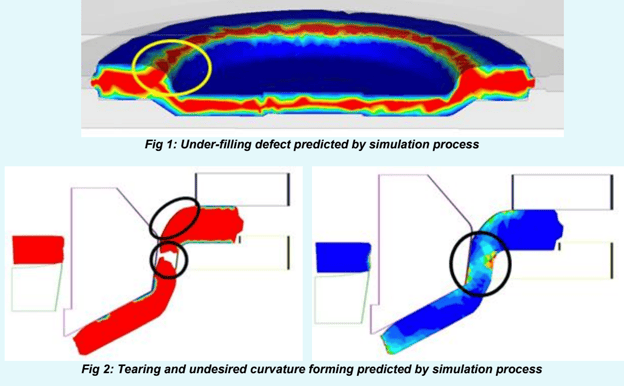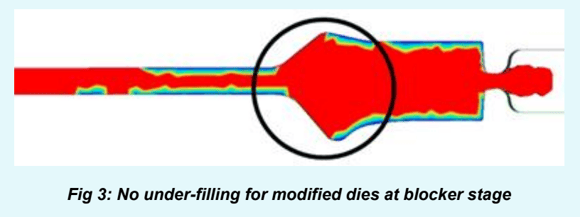Digital engineering in manufacturing is rapidly becoming an essential aspect of competing as a modern, streamlined company. Digital engineering takes a holistic view of your organization and ensures that software, logistics, budgeting, IT, and related key functions align to efficiently support the manufacturing process.
Otherwise, it’s easy for companies to fall into the trap of accidentally creating informational silos that contribute to process inefficiencies. Digital engineering for manufacturing applies concepts from traditional engineering, such as eliminating waste and designing stable structures, to develop digital frameworks instead of physical machines.
Increased Product Design Flexibility
By allowing engineers to accurately test initial designs, forging simulation software opens up various possibilities for product design flexibility. Not only does this help companies innovate faster, but it also informs decision-making about custom items, rework, and designing new components to replace obsolete parts in an existing design.
Increased design flexibility also allows manufacturers to penetrate different markets and expand their respective competencies. Experimenting with new techniques or responding to a request for a custom product is far less risky when leveraging digital engineering for manufacturing to tackle calculations and internal data management.
Cost Savings in Shop Floor Trials
Using simulation models can significantly reduce testing and prototyping costs. For example, forging simulations can accurately evaluate product designs for manufacturability without requiring a physical prototype. These simulations can predict dimensional tolerances, surface quality, flow stresses, metallurgical particle distribution, and temperature improvements without requiring expensive physical prototyping.
With digital engineering solutions, forging manufacturers can pre-test virtual models before committing resources toward development.
Reduced Time to Market
Even small delays in day-to-day processes can accumulate significant losses. Something as simple as having shared digital spaces for files and drafts can eliminate downtime, avoid miscommunications, and ensure that everything remains up to date in real time.
Working from a single shared version of a draft guarantees that any analysis performed will be reflected in the current state of a design. This is especially important when predicting manufacturing times, generating schedules, or planning product launches.
Forging Optimization Process: A Digital Engineering Case Study
The aforementioned benefits of digital engineering for manufacturing are best illustrated by examining businesses that have already incorporated these principles as part of a successful digital transformation. Simulation software FORGE® has continued to lead the way in digital engineering by optimizing the development process of forged parts for the automotive and aeronautics industries, among others.
Since FORGE® anticipates defects and potential points of failure, manufacturers are free to innovate with confidence without wasting money and materials on unnecessarily conservative safety margins.
Once parameters are adjusted to account for the software’s feedback on anticipated defects and how a particular product will affect equipment in terms of stress and abrasive wear, it’s possible to create an advanced physical prototype that has already passed quality control in a digital space.
Challenge: Reduce Waste & Per-Piece Manufacturing Costs
Through conventional forging, a circular flange was produced in two distinct stages: blocker hammering and hydraulically-driven trimming/piercing/drawing. Unfortunately, this process suffered from several defects:
- Underfilled parts during blocking
- Undesired curvature formation,
- Tearing in the combined operation, leading to shortened tool life
Strategy: Simulate Existing Forging Process to Capture Defects

Fig.1 FORGE® simulation capturing under-filling during the blocker stage.
Fig 2 FORGE® simulation showing tearing and undesired curvature forming during production.
We built a simulation of the existing forging process to generate a visualized diagnosis. Essential parameters were meticulously accounted for during the building process to create an accurate simulation model. This included initial billet size, material specs, thermal details, die design outline, lubrication details, etc.
The simulation revealed under-filling during the blocker stage, along with tearing and undesired curvature forming during the forging process. This led to the gradual loss of tooling material and premature failure in formed parts. (Fig 1-2)

Fig 3 shows results after modifying dies during the blocker stage.
After careful analysis, it was discovered that an inadequate die design was causing excess material to build up at the center of the flanges instead of filling the corners. To solve this, we ran additional simulations by adjusting draft angles, inclinations, fillets, and curvatures to find the optimal billet size. We ultimately found it best to modify the billet from a rectangular cross-section into a cylindrical one (see Fig 3).
Results: Positive Impact on Bottom Line
Fig. 4 FORGE® simulation showing no forging defects. Fig. 5 Considerable reduction in press load requirement.
Modifying the forging process resulted in a more efficient material flow, reducing stress concentration and mitigating potential forging defects. The new die design for this stage was so successful that press load requirements were reduced by almost one-third. Overall, digital engineering through forging simulation led to:
- Improved tool life durability
- Improved product quality
- Reduction in production costs
- Lower energy consumption and less waste
Digital Engineering for Manufacturing Leads to Growth
As the world of digital engineering continues to evolve, manufacturers need to stay up-to-date and adapt their practices accordingly. By understanding the basics of digital engineering for manufacturing and its many other applications, manufacturers can position themselves as leaders in the industry and better serve their customers.


